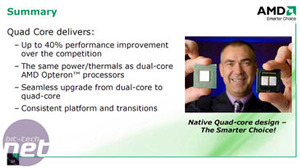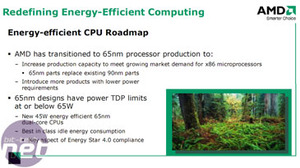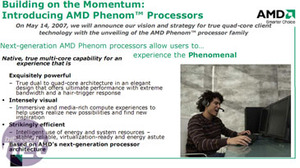
AMD Phenom
AMD originally released its Athlon 64 processors, the first capable of running 32- and 64-bit x86 instructions on the same CPU, back in 2003. Not only was this revolutionary but it also had an integrated memory controller, rather than relying on one usually integrated into the northbridge to do the work.Integrating it on die allowed AMD to massively increase the performance of its CPUs because now everything was on piece of silicon, latencies were greatly reduced.
Back then (as is also the case now), AMD announced the Opteron server processors before its consumer range. Just two years later in 2005 AMD released its Athlon 64 X2 range, and while it wasn’t the first dual core CPU to market it did make the first with native dual cores.
Continuing its biennial update schedule, AMD has once again updated its CPU range for native quad cores starting with the Opteron.
Later this year in Q3, we will be seeing the fruits of its labour in the consumer market and it won’t just be another refresh of the Athlon 64 range, it’ll be an entirely new branding under the name ‘Phenom’.
A few weeks back in Tunisia, AMD remarked how it would like to associate the product as being “Phenomenal”. My first associative thoughts were drawn to “Phantom” and other heroic comic book-esq attire (as opposed to vapourware consoles), before fellow hacks kindly corrupted my mind with alternative ideas.
A natural resistance to change is inevitable and whether you love it or loath it, the name is here to stay. Although curiously, why AMD has shunned its biggest brand and most recognised motif to date is unknown.
Some have suggested it’s a marketing tactic to match Intel’s shift from Pentium to Core, but that was only done because of the final dismal performance of the Pentium range with NetBurst. The Core architecture represents a massive underlying change from that. In contrast, AMDs Phenom builds off Athlon traits and is still essentially its direct underlying heritage.
Others have suggested that AMD just wants to create more well known brands like Opteron, Athlon, and Sempron, associating Phenom with the high performance power user only. In this way Opteron will stay server only, Athlon will become mid range consumer (and remain the largest selling) and Sempron will exist for value. Future projects like Fusion could additionally mean that Phenom becomes a platform brand as well.
The Athlon range is currently set to not get an update to the new architecture, and the directly associated quad core treatment. Instead Phenom will carry on the ultra-enthusiast FX brand, as well as becoming available in more fiscally friendly Phenom X4 and Phenom X2 ranges.
The updated Opteron and new Phenom represent not only a native quad core CPU, but also a whole host of optimisations and evolutionary changes including SSE4, shared L3 cache, increased HyperTransport speeds, along with improved virtualisation technology and power states as well.
Despite these four cores and remaining on 65nm for at least another year, AMD has committed to setting an upper limit of 95W thermal design power (TDP), with low power 68W solutions being available on certain lines as well.
In the past Opteron processors have used Socket 940, and briefly 939 since 2003 with the discontinuation happening just this year with the move to Socket F (LGA1207). Quad core AMD Opterons will still be made for Socket F, and a simple BIOS update will allow them to work with existing boards. This means you can essentially double the power of your existing setup without having to completely overhaul its underlying infrastructure. Even the Shanghai core, slated for release next year on 45nm will also be Socket F with AMD committing support for the socket until at least 2009.

MSI MPG Velox 100R Chassis Review
October 14 2021 | 15:04














Want to comment? Please log in.